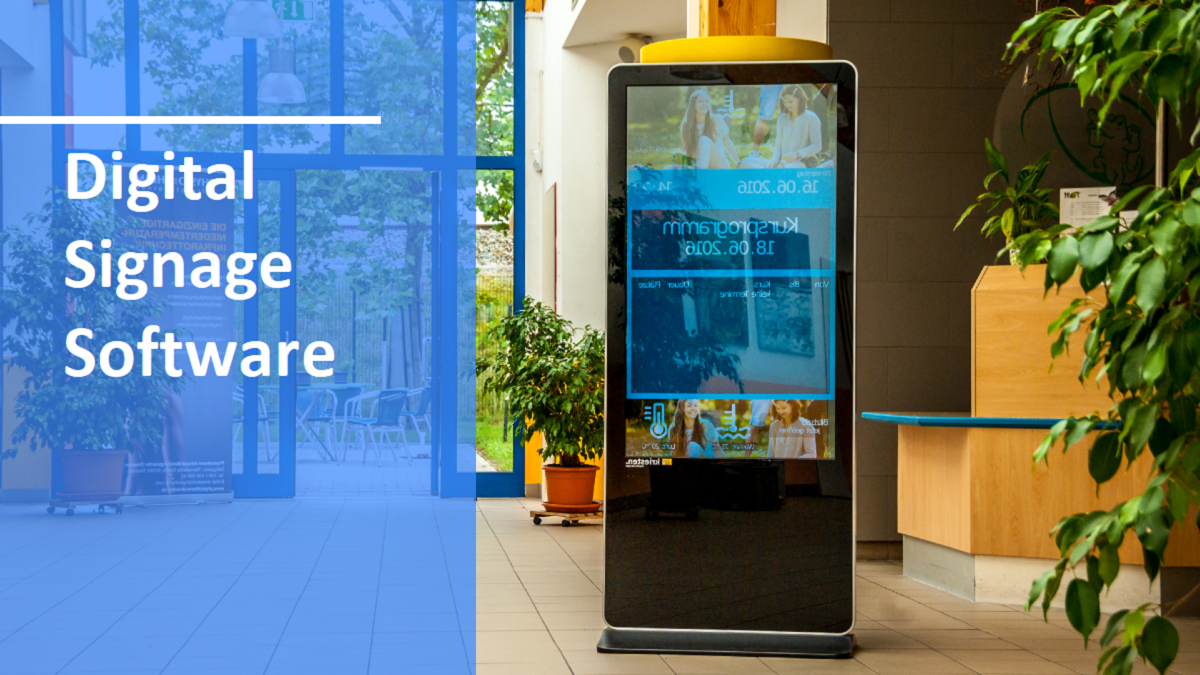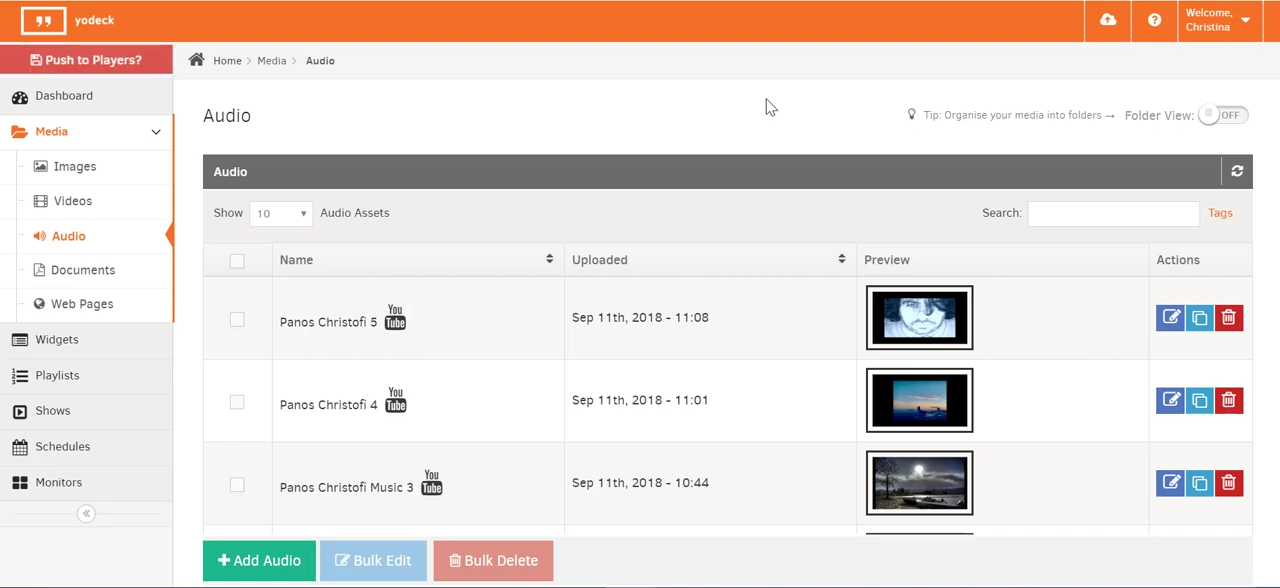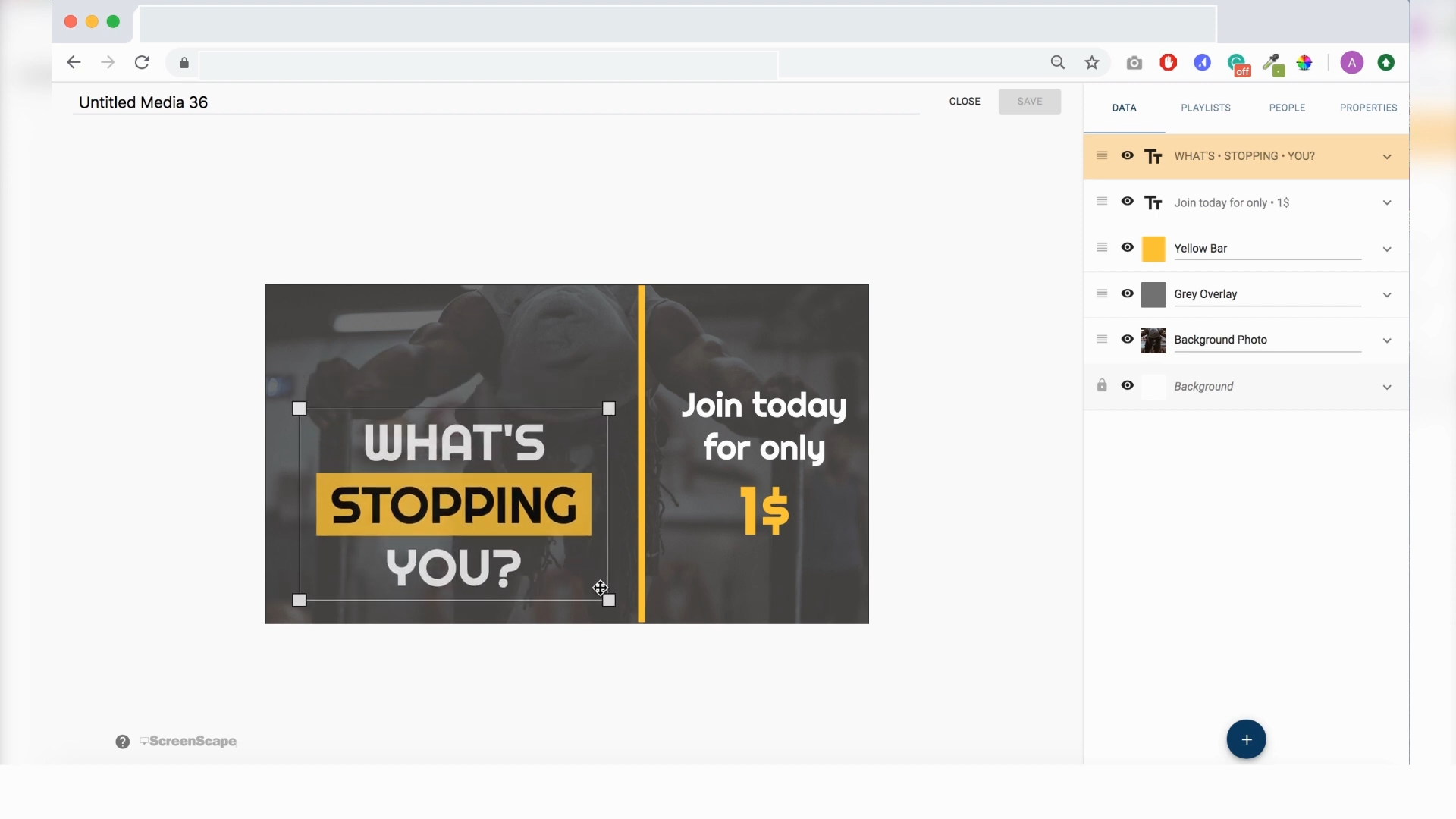Are your posters not converting leads into customers? Is it getting harder to publish new materials in time for your customers to see them? Has it become expensive to create traditional signage for your expanding business? Fortunately, digital signage software provides new ways to market and sell your products and services without spending a lot.
These platforms provide a scalable and flexible solution to ensure that you can take advantage of revenue opportunities. Digital displays are much easier to manage while increasing your reach to your customers.
In fact, over 70% of Americans will see a digital display in a month, which shows its effectiveness. You can upsell to your existing customers in your place of business without much effort from your staff. Furthermore, they are also easy to manage even if you have a multi-location business.
In this article, we will explore what digital signage software is. We will also show what such a system can do for you and your business. Also, do not miss our list of leading digital signage software in the market.

Digital Signage Software Table of Contents
What is a Digital Signage Software?
Digital signage software helps in the management of content, static and interactive, on digital displays. It allows you to create, schedule, and display various multimedia elements and custom branding to advertise on televisions, projectors, and other types of digital displays.
These systems enable organizations and companies to broadcast advertisements, signs, and informational content. Interactive displays with custom branding are usually found on places of business installed or mounted on walls, entryways, lobbies, and more. Additionally, digital signage is also used in airports, restaurants, hotels, malls, and more.
List of Best Digital Signage Software
Digital signage platforms come in various features and capabilities. Here are some of the best options on the market:
- Scalefusion: This platform allows you to turn Android, iOS, and Windows 10 devices into digital signage for kiosks. It supports multiple file formats, plays media in a loop, and lets you speed up or slow down your presentation.
- Yodeck: A cloud-based digital signage software that makes it easy to publish your content wherever you are. Aside from various media content, it also includes free widgets that can display dynamic information such as a clock, weather, social media feeds, slideshow, and more. You can even offer a WiFi share capability for your customers.
- OnSign TV: This professional signage platform allows you to develop dynamic content using apps, RSS feeds, YouTube videos, social media posts, and more. Additionally, you can schedule your marketing efforts to take advantage of various opportunities. It also allows you to publish content based on regions and zones.
- Scala Digital Signage: Scala does not only offer digital signage software but an entire service from hardware to apps. They provide personalized digital experiences, which include automation. The app also offers ordering display systems, service automation, and other cutting-edge signage technology.
- Play Digital Signage: A software that includes a content creation functionality where you can add text, colors, images, videos, plugins, and more. The editor includes various tools so you can develop content easily and quickly. Furthermore, it includes built-in analytics that can tell you the performance of each display.
- Broadsign: This company offers various cloud-based signage solutions, which include Broadsign Control, Broadsign Direct, and Broadsign Publish. These functionalities allow you to manage your content and network. It also includes an easy-to-learn editor where you can customize your media.
- ScreenCloud: A system that makes it easy for you to create and control the content on one or many screens. You can set up smart schedules and create expiration for your content to ensure that it is always fresh. You can even create channels based on topic or teams.
- Enplug Digital Signage: This platform promises to make it easy to scale your marketing and sales communication. It includes a robust social media wall that pulls content from various platforms such as Instagram, Youtube, RSS, and more. It comes with custom color themes, which means you do not have to create your content from scratch.
- Raydiant Screen Signage: A digital signage application that can turn any TV into beautiful, interactive signage. It includes solutions for single-location, multi-location, and enterprise businesses. The set-up takes less than five minutes, which means you can start publishing your content right away. It comes with a dashboard that makes it easy to manage and create content for one or multiple screens.
- Rise Vision Digital Signage: A platform offering a flexible solution that allows you to publish content beyond marketing and sales. You can create announcements, welcome signs, alerts, and more. It also comes with customizable templates that will make your content eye-catching and dynamic.
- ScreenScape: This digital signage system is a plug-and-play solution, which means you will not run into any compatibility issues with your screens. It includes a robust asset management system that you can connect to your Instagram, Facebook, Dropbox, or Google Drive. Aside from software solutions, ScreenScape also offers hardware for any type of digital signage.
- AIscreen: This is an advanced digital signage platform that streamlines content management, saving you time and money. With its responsive design and user-friendly drag-and-drop interface, it simplifies the creation and distribution of dynamic content. AIScreen offers a wide range of integrated business solutions, enhancing your digital signage capabilities.

Yodeck’s media library makes it easy to manage all digital assets.
Core Parts of Digital Signage Software
While most digital signage applications serve as all-in-one systems, they are composed of three core parts:
- Digital screen – This is the part that your customers and target audience see. It simply displays all your digital content through devices, such as flat-screen TVs. However, as display technology gets better, more custom displays are becoming available. Displays with touchscreen functionality are also available on the market for a more interactive experience.
- Digital signage player – It can be a type of hardware or software solution. Players usually store the digital content and connect to your display for playback. Some of the most common examples are Amazon Fire Stick, Google Chromecast, or even a simple thumb drive. Additionally, the player and the content can be stored in the cloud or a local server connected to the display through a network.
- Content management – The features of a content management system (CMS) vary per digital signage application. At its most basic functionality, it lets you upload images, audios, or videos. Some CMS even allows you to create your own content right in the system from scratch or using a template.
Other Features of Digital Signage Software
Aside from the three key parts, there are features that a robust digital signage application should have. Here are a few:
- Media library – A digital signage software should allow you to manage and store all your media assets, such as texts, images, audios, videos, and more.
- Content scheduling – Create and manage schedules for your digital content publications. It can also include a calendar view for easy scheduling.
- Layout management – Depending on your display type, you should be able to create custom layouts to maximize the screen’s real-estate where you can display different types of content at the same time.
- Display management – You should be able to manage multiple display boards in one place. Other digital signage systems even include remote display management.

Screenscape includes layout editor and management to ensure that you maximize your screen.
Key Advantages of Digital Signage Software
Digital signage platforms allow you to reach potential customers that you otherwise cannot. As such, it has become a great marketing software for businesses looking to engage their customers. Here are some of its key advantages:
- Interactive content – Instead of relying on traditional printed materials, digital signage systems allow you to create interactive content that will surely catch the attention of your audience. You can display videos, slideshows, and more. Other apps can even show your social media newsfeed for enhanced engagement.
- Flexibility – An entire digital signage system can be used on different types of marketing and sales campaigns. You can publish content at a fraction of the time used to create printed ads. Platforms that use the cloud as a store even allow you to change content remotely.
- Scalability – If your business is expanding, all you have to do is add new displays, and the system should be able to accommodate them. Additionally, each display can show localized content. This is great if you have various branches in different locations with their customized content.

Screencloud provides a scalable solution that allows you to manage various screens across different locations.
Common Issues When Using Digital Signage Software
Just like any system, digital signage platforms encounter various problems. Here are a few:
Hardware
- Screen type – Your content should be compatible with the type of screen that you have. Aside from the usual LCD, new types of displays are now available such as OLED, indoor LED, and even ePaper. Your content should be consistent across various displays.
- Screen size – Your content will also depend on the size of the display that you have. Most content should be able to adjust to minor size variations. However, if you are using different displays, such as TVs, smartphones, and more, you should create custom content for each to ensure that it is properly displayed.
Bandwidth
Many digital signage apps take advantage of the convenience that cloud technology offers. However, this comes with its own issues. For example, around 16% of major banks struggle to provide enough bandwidth to their digital displays. That means missed opportunities to provide information and market new products and services.
If you are using a lot of videos and other multimedia files, you will require a faster Internet connection. For instance, a high-resolution video (1080i) requires about 140 MB per minute. Aside from speed, stability is also necessary to display such content without affecting content delivery.
Furthermore, if you are using a virtual private network, then it may have bandwidth limitations. Ensure that you have tested your content with the connection that you have. Or create content that is optimized for the available bandwidth.
Localized Content
A popular trend in marketing nowadays is delivering personalized content. This creates a stronger connection with the customers. As such, localized content is very important.
However, it can be a challenge if your business has multiple branches, each with their individual marketing efforts. You can allow each branch to develop and publish their own digital signage. However, this can affect the overall consistency and branding of the content.
Another potential solution is to create targeted messaging within the content. This can be done by using the local language or featuring a popular product in the branch without changing the entire content. Experts say that 75% of customers prefer products and services in their local language.
A simple way to localize your digital signage is to take advantage of the local social media feeds. This can even improve your local business’s interaction with the local customers. Furthermore, you can add small elements to the display, such as the local weather.
Future Trends of Digital Signage Software
The future is exciting for digital signage software, especially with the new ways through which you can advertise and market to the customers. Here are some of the future trends that you can expect to see on digital signage:
- Input sensors – Aside from improvements in display quality, developers are creating technologies to collect information from its surroundings and audience. Built-in cameras and proximity sensors allow displays to know when a person is nearby. Microphones and touchscreen technologies allow digital signage apps to interact with customers directly.
- Better customer interaction – The combination of the hardware technologies mentioned in the previous item means you can deploy better content. For example, chatbots are making their way to digital signage. Customers can “talk” to the signage if they need information, purchase recommendations, and support.
- Enhanced analytics – As the ability of displays to collect input gets better, systems can provide better analytics and insights. You can determine which content is effective and what modifications are needed to improve your marketing performance.
